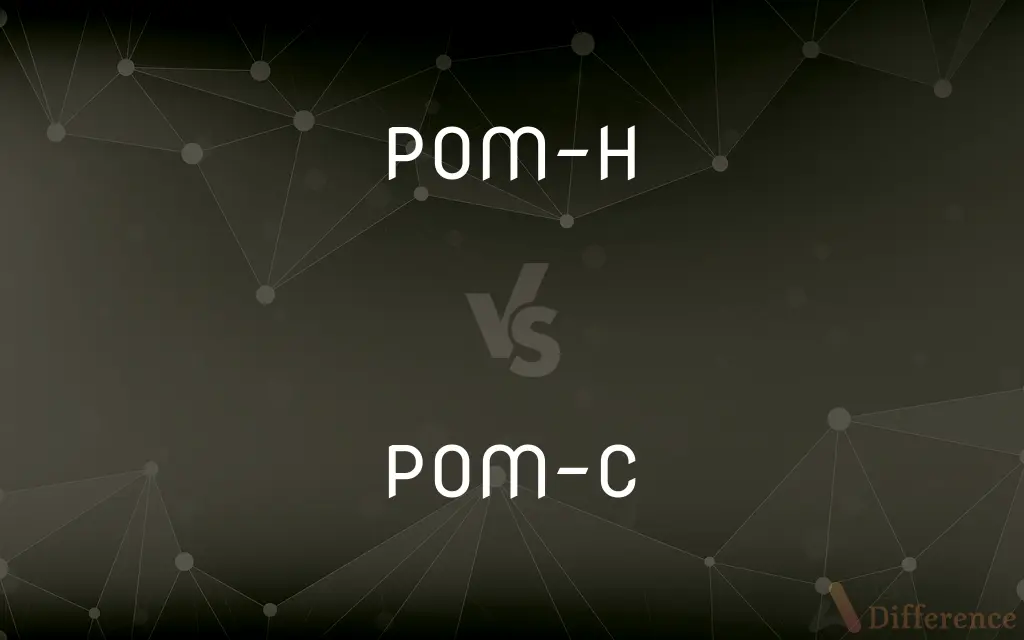POM-H vs. POM-C — What's the Difference?
By Tayyaba Rehman & Fiza Rafique — Published on February 17, 2024
POM-H (Polyoxymethylene Homopolymer) has higher mechanical strength and rigidity. POM-C (Polyoxymethylene Copolymer) offers better thermal stability and chemical resistance.

Difference Between POM-H and POM-C
Table of Contents
ADVERTISEMENT
Key Differences
POM-H (Polyoxymethylene Homopolymer) and POM-C (Polyoxymethylene Copolymer) are two types of polyacetal, a thermoplastic used in precision parts requiring high stiffness, low friction, and excellent dimensional stability. POM-H is characterized by its high mechanical strength, rigidity, and resilience at temperatures below its melting point. It is suitable for applications where strength is a critical factor, including gears, bearings, and structural components in machinery. POM-H's homopolymer structure contributes to its superior physical properties but makes it slightly less resistant to hot water and chemicals compared to POM-C.
POM-C, on the other hand, incorporates comonomer units in its polymer chain, enhancing its thermal stability and resistance to chemicals. This makes POM-C more suitable for applications involving high temperatures or exposure to harsh chemical environments. While it maintains many of the beneficial properties of POM-H, including low friction and good wear resistance, POM-C's mechanical strength and rigidity are slightly lower. Its enhanced chemical resistance makes it preferred for parts used in chemical processing, hot water applications, and where lower formaldehyde emissions are required.
The choice between POM-H and POM-C depends on the specific requirements of the application. POM-H's higher strength and rigidity make it ideal for mechanically stressed parts, while POM-C's better chemical resistance and thermal stability suit environments where these factors are more critical. Both types of POM offer excellent machinability and are widely used in the automotive, electrical, and consumer goods industries for a variety of components.
Manufacturers often select POM-H for its performance in precision applications where dimensional stability over a wide range of temperatures is necessary. Conversely, POM-C is chosen for components that may experience chemical exposure or need to operate in higher temperature ranges. Both materials are recognized for their durability and longevity in challenging environments.
In essence, while POM-H and POM-C share many properties characteristic of polyacetal plastics, including high strength, low friction, and excellent machinability, their differences in chemical composition lead to distinct advantages in mechanical strength for POM-H and in thermal and chemical resistance for POM-C. These distinctions guide engineers and designers in selecting the appropriate material based on the operational demands of the final product.
ADVERTISEMENT
Comparison Chart
Mechanical Strength
Higher than POM-C
Lower than POM-H
Chemical Resistance
Lower than POM-C
Higher than POM-H
Thermal Stability
Good, but less than POM-C
Better than POM-H
Applications
Gears, bearings, structural components
Chemical processing parts, hot water applications
Resistance to Hot Water
Less resistant
More resistant
Compare with Definitions
POM-H
Offers superior mechanical properties among polyacetals.
For load-bearing applications, POM-H is the preferred material.
POM-C
Offers reduced formaldehyde emission compared to POM-H.
Food industry machinery often incorporates POM-C for safety.
POM-H
Exhibits lower formaldehyde release than POM-C.
POM-H components are favored in sensitive electronic equipment.
POM-C
Thermoplastic with excellent chemical resistance.
POM-C is chosen for parts exposed to harsh chemicals.
POM-H
High-strength, rigid plastic used in precision parts.
POM-H gears exhibit excellent durability under stress.
POM-C
Versatile in applications requiring chemical and thermal resilience.
POM-C is ideal for pump parts in chemical processing plants.
POM-H
Ideal for components requiring toughness and resilience.
POM-H is used in automotive parts for its toughness.
POM-C
Preferred for applications involving hot water.
POM-C valves are used in plumbing due to their hot water resistance.
POM-H
Less suited for chemical exposure than POM-C.
In chemically aggressive environments, POM-H may degrade faster.
POM-C
Slightly lower mechanical strength but better thermal stability.
For high-temperature applications, POM-C offers reliable performance.
Common Curiosities
What are POM-H and POM-C?
Both are types of polyacetal, a thermoplastic, with POM-H being a homopolymer and POM-C a copolymer.
How do POM-H and POM-C differ in application?
POM-H is used for mechanically stressed parts, while POM-C is for chemically exposed or high-temperature parts.
Which has better chemical resistance, POM-H or POM-C?
POM-C has better chemical resistance.
Are there environmental concerns associated with POM-H or POM-C?
While not biodegradable, proper handling and recycling can mitigate environmental impact.
How do POM-H and POM-C compare in wear resistance?
Both offer excellent wear resistance, suitable for high-wear applications.
Why might one choose POM-C over POM-H for hot water applications?
POM-C's better thermal stability and chemical resistance make it more suitable.
How does temperature affect POM-H and POM-C?
POM-C generally handles higher temperatures better than POM-H.
Are POM-H and POM-C biodegradable?
No, both are not biodegradable but can be recycled.
Which is more expensive, POM-H or POM-C?
Pricing can vary based on suppliers, but differences are usually minimal.
Can POM-H and POM-C be machined easily?
Yes, both materials are known for their excellent machinability.
Can POM-H and POM-C be used in food contact applications?
Yes, both can be used, but POM-C is often preferred for its lower formaldehyde release.
What makes POM-H more suitable for high-strength applications?
Its homopolymer structure provides higher mechanical strength and rigidity.
How do POM-H and POM-C compare in electrical properties?
Both have good electrical insulating properties, suitable for electronic components.
What are the safety precautions for machining POM-H and POM-C?
Proper ventilation is necessary due to the potential release of formaldehyde gas when heated.
Can POM-H and POM-C be colored or dyed?
Yes, both can be colored during manufacturing.
Share Your Discovery

Previous Comparison
Last vs. The Last
Next Comparison
Anorexia vs. Anorexia NervosaAuthor Spotlight
Written by
Tayyaba RehmanTayyaba Rehman is a distinguished writer, currently serving as a primary contributor to askdifference.com. As a researcher in semantics and etymology, Tayyaba's passion for the complexity of languages and their distinctions has found a perfect home on the platform. Tayyaba delves into the intricacies of language, distinguishing between commonly confused words and phrases, thereby providing clarity for readers worldwide.
Co-written by
Fiza RafiqueFiza Rafique is a skilled content writer at AskDifference.com, where she meticulously refines and enhances written pieces. Drawing from her vast editorial expertise, Fiza ensures clarity, accuracy, and precision in every article. Passionate about language, she continually seeks to elevate the quality of content for readers worldwide.
















































